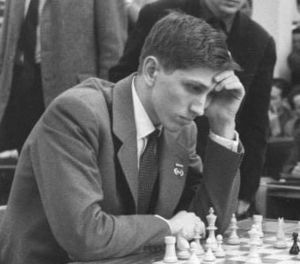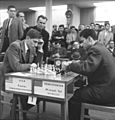Bobby Fischer facts for kids
Quick facts for kids Bobby Fischer |
|
|---|---|

Fischer playing in Leipzig in 1960
|
|
| Full name | Bobby Fischer |
| Country | United States, Iceland |
| Born | March 9, 1943 Chicago, Illinois, United States |
| Died | January 17, 2008 (aged 64) Reykjavík, Iceland |
| Title | Grandmaster |
| World Champion | 1972–1975 (FIDE) |
| Peak rating | 2785 (July 1972) |
Robert James "Bobby" Fischer (March 9, 1943 – January 17, 2008) was an American-Icelandic chess Grandmaster. He was the eleventh World Chess Champion.
As a teenager, Fischer became famous worldwide for his amazing chess skills. He won the American championship in 1963/64. He won all eleven of his games in that tournament.
Contents
Early Life
Fischer was born in Chicago, Illinois, on March 9, 1943. His mother, Regina Wender Fischer, was an American citizen. She was born in Switzerland and later became a teacher, nurse, and doctor. Bobby grew up with his mother and older sister. In 1949, they moved to Brooklyn, New York.
Some reports suggest that Paul Nemenyi, a doctor, was Bobby's biological father. Nemenyi helped pay for Fischer's schooling until he passed away in 1952.
Chess Journey
In March 1949, six-year-old Bobby and his sister Joan learned chess. They used the instructions from a chess set bought at a candy store. When Joan stopped playing, Bobby often played against himself. That summer, he found a book of old chess games and studied it very carefully.
The family moved to Brooklyn in 1950. Bobby became so focused on chess that his mother worried. She tried to find other kids for him to play with. This led her to Hermann Helms, a famous American chess expert. Helms told her about a chess event where Max Pavey, a former Scottish champion, would play many people at once. Bobby played in this event in 1951. He lost, but he impressed everyone.
One person watching was Carmine Nigro, the president of the Brooklyn Chess Club. Nigro was a strong chess player and a teacher. He was so impressed that he invited Bobby to the club and started teaching him. Bobby later said that meeting Mr. Nigro was a key moment in his chess journey.
Nigro held Bobby's first chess tournament at his home in 1952. In 1955, when Bobby was 12, he joined the Manhattan Chess Club. Nigro continued to teach Fischer until 1956.
Fischer became famous around the world in 1956. He was only 13 when he played a game against an American player named Donald Byrne. In this game, Bobby gave up his queen to win. Chess Review magazine called this game the "game of the century."
Winning US Championships
Fischer was 14 when he won the U.S. Championship for the first time. He played in eight US Championships in total. He won every single one of them by at least one point. His results were:
| US Champ. | Score | Place | Margin of victory | Percentage | Age |
|---|---|---|---|---|---|
| 1957/58 | 10½/13 (+8−0=5) | First | 1 point | 81% | 14 |
| 1958/59 | 8½/11 (+6−0=5) | First | 1 point | 77% | 15 |
| 1959/60 | 9/11 (+7−0=4) | First | 1 point | 82% | 16 |
| 1960/61 | 9/11 (+7−0=4) | First | 2 points | 82% | 17 |
| 1962/63 | 8/11 (+6−1=4) | First | 1 point | 73% | 19 |
| 1963/64 | 11/11 (+11−0=0) | First | 3½ points | 100% | 20 |
| 1965 | 8½/11 (+8−2=1) | First | 1 point | 77% | 22 |
| 1966/67 | 9½/11 (+8−0=3) | First | 2 points | 86% | 23 |
Fischer stopped formal schooling at age 16. However, he taught himself several foreign languages. This allowed him to read chess magazines from other countries. Chess experts said that Fischer's dedication to chess was unmatched.
Becoming World Champion
In 1972, Bobby Fischer became the first and only American to win the World Chess Championship in the 20th century. The match took place in Reykjavík, Iceland. This event was a huge media sensation. It was called "The Match of the Century." It was even on the front page of newspapers around the world.
Before and during the match, Fischer focused on his physical fitness. This was a new idea for top chess players at the time. He believed being fit helped his chess game. He played a lot of tennis and swam often.
To win the title, Fischer beat Boris Spassky from the Soviet Union.
When Fischer returned to New York, there was a "Bobby Fischer Day." The number of people joining the US Chess Federation doubled in 1972. This period is often called the "Fischer Boom" in American chess. This championship match got more attention worldwide than any other chess championship before or since.
Fischer was supposed to defend his title in 1975 against Anatoly Karpov. Karpov had become the new challenger. However, Fischer did not agree to play the match. Because of this, he lost his title in 1975. The title of world champion was then given to Anatoly Karpov.
Life After the Championship
After being out of the public eye for twenty years, Fischer played Spassky again in 1992. This match was called the "Revenge Match of the 20th century." It happened in Yugoslavia, even though the United Nations had put rules in place that included stopping business activities there. Fischer insisted the match be called "The World Chess Championship." He believed he was still the true World Champion.
The prize money for this rematch was US$5 million. The winner received $3.35 million. This was, and still is, the largest prize ever for a chess match. Fischer won the match with 10 wins, 5 losses, and 15 draws.
The United States Department of State had told Fischer not to play in Yugoslavia. Because he did not follow this order, he could have faced legal trouble if he returned to the U.S. He never went back to the United States. This 1992 rematch was the only time Fischer played chess in public after becoming world champion.
After this match, Fischer promoted a new type of chess. He called it "Fischer Random Chess." In this game, the chess pieces are mixed up randomly at the start. This means every game begins with a different setup.
In July 2004, Fischer was arrested in Japan because his passport was not valid. The United States wanted him to return to face trial for playing chess in Yugoslavia in 1992. The government of Iceland eventually made Fischer a citizen of Iceland. He lived a quiet life there, away from the public.
Passing Away
Bobby Fischer passed away from kidney failure on January 17, 2008. He was buried in a small ceremony near Selfoss, Iceland.
Beliefs
Fischer was born Jewish, but he later said he did not follow the religion.
Mental Health
Fischer had a history of disagreements and conflicts throughout his life. He often believed that people were plotting against him. Some experts have suggested that Fischer showed signs of paranoia, a type of mental illness. Authors Hans Böhm and Kees Jongkind wrote that Fischer's radio talks showed he was "out of his mind." They believed he was "a victim of his own mental illness."
Bobby Fischer Teaches Chess
Fischer created his own book to teach chess. It uses a special method called programmed learning.
Fischer Clock
In 1988, Fischer invented a new kind of chess clock. This clock gives each player a set amount of time at the start of the game. Then, it adds a small amount of extra time after each move they complete.
An example of Fischer's clock was made for and used in the 1992 rematch between Fischer and Spassky. Clocks based on the "Fischer clock" soon became the standard in major chess tournaments. Fischer later felt he did not get all the money he deserved for his invention.
Chess Game Statistics
Bobby Fischer played 752 tournament games in his career. He won 417 games, drew 251, and lost 84. If we only look at games after he turned 20, he played 311 tournament games and lost only 23. This means he lost only about 7.4% of those games.
Images for kids
-
Fischer at 17 playing 23-year-old World Champion Mikhail Tal in Leipzig, East Germany
-
Fischer's scoresheet from his round 3 game against Miguel Najdorf in the 1970 Chess Olympiad in Siegen, Germany
-
Fischer in Belgrade for the USSR vs. Rest of the World match in 1970
See also
 In Spanish: Bobby Fischer para niños
In Spanish: Bobby Fischer para niños







